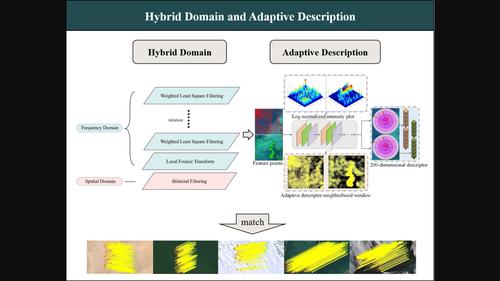Weak texture remote sensing image matching based on hybrid domain features and adaptive description method
引用次数: 0
Abstract
Abstract Weak texture remote sensing image (WTRSI) has characteristics such as low reflectivity, high similarity of neighbouring pixels and insignificant differences between regions. These factors cause difficulties in feature extraction and description, which lead to unsuccessful matching. Therefore, this paper proposes a novel hybrid‐domain features and adaptive description (HFAD) approach to perform WTRSI matching. This approach mainly provides two contributions: (1) a new feature extractor that combines both the spatial domain scale space and the frequency domain scale space is established, where a weighted least square filter combined with a phase consistency filter is used to establish the frequency domain scale space; and (2) a new log‐polar descriptor of adaptive neighbourhood (LDAN) is established, where the neighbourhood window size of each descriptor is calculated according to the log‐normalised intensity value of feature points. This article prepares some remote sensing images under weak texture scenes which include deserts, dense forests, waters, ice and snow, and shadows. The data set contains 50 typical image pairs, on which the proposed HFAD was demonstrated and compared with state‐of‐the‐art matching algorithms (RIFT, HOWP, KAZE, POS‐SIFT and SIFT). The statistical results of the comparative experiment show that the HFAD can achieve the accuracy of matching within two pixels and confirm that the proposed algorithm is robust and effective.

基于混合域特征和自适应描述方法的弱纹理遥感图像匹配
摘要弱纹理遥感图像具有反射率低、相邻像元相似度高、区域间差异不显著等特点。这些因素给特征提取和描述带来困难,导致匹配失败。因此,本文提出了一种新的混合域特征和自适应描述(HFAD)方法来进行WTRSI匹配。该方法主要有两个贡献:(1)建立了一种结合空间域尺度空间和频域尺度空间的特征提取器,其中结合相位一致性滤波器和加权最小二乘滤波器建立频域尺度空间;(2)建立了一种新的自适应邻域描述符(LDAN),其中每个描述符的邻域窗口大小根据特征点的对数归一化强度值计算。本文准备了一些弱纹理场景下的遥感图像,包括沙漠、茂密森林、水域、冰雪和阴影。数据集包含50个典型的图像对,在这些图像对上展示了所提出的HFAD,并将其与最先进的匹配算法(RIFT、HOWP、KAZE、POS‐SIFT和SIFT)进行了比较。对比实验的统计结果表明,HFAD可以达到两个像素内的匹配精度,验证了该算法的鲁棒性和有效性。
本文章由计算机程序翻译,如有差异,请以英文原文为准。
求助全文
约1分钟内获得全文
求助全文

 求助内容:
求助内容: 应助结果提醒方式:
应助结果提醒方式:


